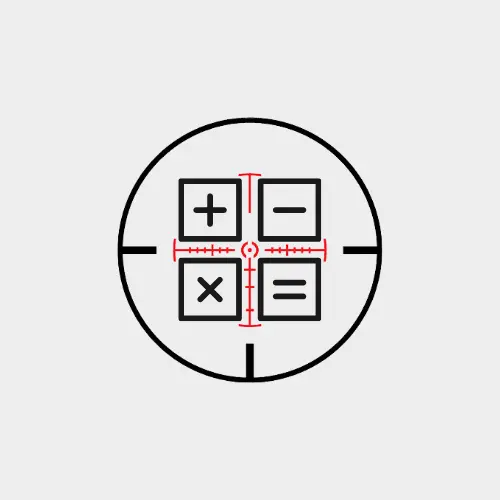SCOPE CLICK CALCULATOR

MOA
The scope says 1 click will move the bullet inch at yards.
I want the bullet to move inch(s) at yards.
MIL
The scope says 1 click will move the bullet MIL.
I want the bullet to move inch(s) at yards.
How to Calculate Scope Clicks
Whether you’re hunting or target shooting, employing a riflescope may improve your accuracy significantly. You must sight in your scope to use it effectively. This involves lining up the intersection of the reticle with the point on the target where the bullet will land.
The windage and elevation adjustment dials, which are both positioned in the center of the scope body, are the tools for modifying the reticle. The distance that the projected point of impact will travel on a target with each turn of the adjustment knobs is known as the scope click value.
Find out how many minutes of angle (MOA) your scope dials are. If this figure is not marked on the dial face, check the manual or get in touch with the manufacturer. The majority of scopes may be adjusted by 1/4 or 1/8 MOA. Fortunately, at a distance of 100 yards, MOA measures conveniently equal to roughly the same measurement in inches. The calculation of scope clicks is based on this data.
Find the distance of your goal in yards, ideally in 100-yard increments. You would raise the value of each click as your range improves and reduce the value as it drops using a scope with a 1/4 MOA at a range of 100 yards as a baseline. You will hear the term MOA to better your knowledge of gunshot accuracy.
The toughest thing to do will be firing on target if you don’t know what it is. Those who are aware of this fact understand that certain calculations are essential if you want to increase your accuracy.
What are those computations, exactly? Will they introduce shooting as a discipline in rocket science? Describe MOA. When we break Minute of Angle down into manageable bits, you’ll realize how simple it is to learn. This will help you strike the target every time you shoot.
As shown in the title, it stands for Minute of Angle. A minute in this context refers to 1/60th of a degree. Consider the number of minutes in an hour. A minute is one-sixtieth of an hour. In the context of shooting, it alludes to a minute portion of one aspect.
View the circle. There are 360 of them. Now subtract one degree and divide the result by 60. The part we are discussing here is that. Despite being so little, it may have a huge impact on whether or not the target is reached. A 1/4 MOA scope, for instance, will shift the point of aim by 1/4 inch with a single click at 100 yards.
The value of each click doubles to 1/2 inch at 200 yards, to 3/4 inch at 300 yards, and so on. In contrast, if you cut the distance in half to 50 yards, your click value would fall by 1/8-inch.
Why Is Shooting Time Measured in Minutes?
When you watch a bullet move, you’ll notice that its arc isn’t perfectly circular. The gravitational pull increases as it moves farther, which causes the velocity to decrease. Thus, the arc’s slope becomes steeper.
You could realize that you are firing directly at targets that are closer to you—say, 200 yards away. You notice that your hits are coming in lower than the target point when you extend your range beyond, say, 600 yards. The bullet drop is the separation between where your shot lands and the target. It has an inch scale.
The trajectory of a bullet is the term used to describe its course. It follows an arc, and for that reason, if we want to adequately cover for the bullet drop, we need to measure it in degrees. MOA is a helpful measurement in this situation.
How do distance and MOA relate to one another?
MOA is not a distance-dependent quantity. If you believed there to be a connection, things are a little murky at this point. Instead of using linear measurements, we employ MOAs. For this reason, we use the elevation turret of a rifle to adjust a long-range target sight. How can we convert MOA to a linear measurement then?
Use this guideline: At 100 yards, one minute (or one MOA) equals one inch. Here, one inch is approximate because it is 1.047 inches. We ignore the 0.047 inches and round it to one for shooting. However, it becomes useful when firing from a distance.
How much does one scope click cost?
Typically, 1 click (0.1 MRAD/MIL) on European rifle scopes moves the hit on a target for 1 cm at 100 meters. On American, Japanese, and Chinese scopes, one-click advances the hit by 1/4 MOA (minute of angle), or 7 mm, at a distance of 100 meters.
